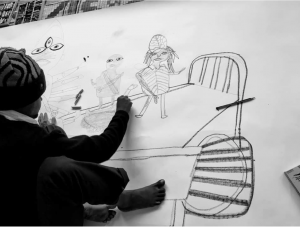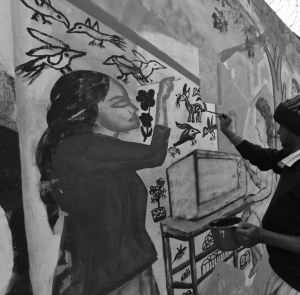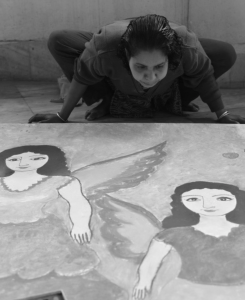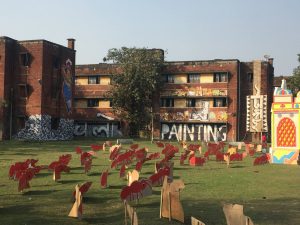Looking for (and Finding) Art in Improbable Places | Kolkata, India
EAS artist and contributor Jayeti Bhattacharaya takes us on a tour of two very different projects that took place in Kolkata during the month of February, when the city lights up with art activities, events and exhibitions.

Kolkata is a city where art and culture have always been truly appreciated, in all its forms and ways, irrespective of all differences. The city has laid a remarkable example of art and culture for the rest of the country.
Last February Kolkata came together to celebrate a festival of the arts with the opening of the Center of International Modern Art Award Show 2019 across three different venues, namely Centre of International Modern Art, Studio 21, and GEM Cinema. Several collateral programs and community art projects took place in the city as well, in particular, the two projects presented here, one at the Calcutta Pavlov Hospital and the other at the CPT colony of Taratola. The two projects, “Across the Line” and “Chalo Painting Tangai “(Let's hang Paintings) were led by two different groups of artists.
A hospital turning into a venue for exhibiting art is something truly unexpected, as our eyes are familiar to look at art in highly polished white cubical space. But yes, in this case the Calcutta Pavlov Hospital turned out to be, for several months, a venue for the exhibition of art, displaying the works of the hospital patients, who worked under the guidance of the artists Srikanta Paul along with Ruma Choudhury, Tanmoy Chakraborty and ANJALI (the NGO working at the hospital). The Calcutta Pavlov Hospital is the place that provides medical attention to those who are suffering from mental illness. As I entered the premises of the hospital the first thing I saw was the black line drawings on both sides of the gate, followed by some installations and several more drawings and pastel coloring.
The entrance black line drawings visually resembled folk painting patterns of India, but definitely with stories embedded within.
When discussing this unusual project with one of the artists involved, and then when looking at the artworks created by the patients, I realized how art can be a strong therapeutic tool, that allows those involved to express their thoughts by recollecting memories in the form of stories and to gush out their emotions through linear and color expressions.
In spite of the exaggerations, the hastiness and the easy enthusiasm, what would catch your eyes was the reflection of honest confessions. The artists here worked with the patients as facilitators, hearing their stories and guiding them to use their memories in constructing the drawings and paintings. Ruma Choudhury, one of the artists working with the patients, explained to me that two things were repeatedly occurring in their stories and in what they were saying: “Home”, obviously expressing the desire to go back home; and “Bed”, which is the place where they are leading their confined lives within the hospital rooms.
Patients working on the walls of the Calcutta Pavlov Hospital. Image courtesy: Ruma Choudhury __________________________________________________________________________________________________________
Nanigopal Rajbanshi, one of the patients, expressed his love for the Hindu gods and goddesses, and his desire to participate in the festivities during the celebration of Durga Puja¹. The flow of his strong lines spoke out about his interest in art. Sita, a lady, revealed to Ruma her constant desire to go back home, and the sadness because nobody came to take her back. These stories, whether directly or indirectly, were reflected in the works.
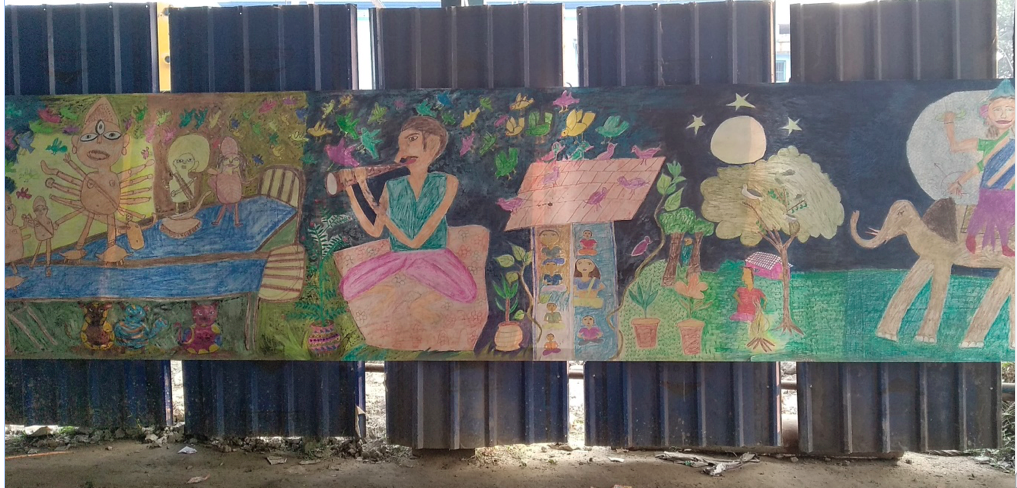
There was a celebration of liberation throughout all the works displayed in the hallways of the hospital. Liberation of thoughts, the liberation of emotions, the liberation of unheard voices, the liberation of unseen memories, tied together on one visual plane, echoed through all the artworks made by the patients residing there.
***********************************************************************************
Looking into the other project, in another part of the city, will make you feel spontaneous, energetic and playful. The project “Chalo Painting Tangai” (Let’s Hang Paintings) was developed by Sunny De Wall collaborative group, in the CPT colony of Taratala. Throughout the site, one could see site-specific installations, cyanotypes, wall posters, cutouts and wall paintings, engulfing the entire space. Here the site has developed into a stage of interaction between the locals and the artworks all around.
Each and every work displayed there was a reflection on the surroundings. The strong colors and huge images were giving form to deep thought observations and interpretations of social life. Walking through the space one could spot an airplane on the ground, a policeman cutout directing the way, the huge head of a boy peeping out, a rocket pushing upward, and so on.
The one thing that will strike the children most is a whole battalion of ant cutouts, standing on the ground as if they were on their way to an expedition. The artist collective says that “the drawings by the children have revealed the intricacies of life that still exist in this area. Through its children, the colony has given us narrations that speak of life and everything in it, through humor- dark and otherwise.”
And the artist Amrita Sen conveyed with joyful words her enthusiasm upon viewing the project: “The amazing transformation of Taratala CPT Colony by Sumantra Mukherjee with his team and Jungle Crow Kids! The row of ants, the 42 building, the presence of essential Asrani, the boy on the rooftop – everything made me immensely excited. Hope next year more and more paras (localities) get this magic touch.”
Photos of CPT Colony project “ Chalo Painting Tangai”. Image courtesy: Amrita Sen
Note: 1.Durga Puja, is an annual five day Hindu festival in the Indian subcontinent that reveres the goddess Durga. It is particularly popular in West Bengal. It is celebrated by the Bengalis all over the world during the month of September and October. Durga Puja festival marks the battle of goddess Durga with the shape-shifting, deceptive and powerful buffalo demon Mahishasura, and her emerging victorious.
Jayeti Bhattacharya is an artist living and working in Kolkata, India. She holds a Master’s of Fine Arts from Kala Bhavana, Visva Bharati University. Her work was shown in many exhibitions, including ‘Defining a Relative Space’ at A.M. Studio; ‘Bad Smell Good Smell’ at Studio 21 in Kolkata; ‘Last Image Show’, both in Dar es Salaam, Tanzania in 2018 and Lusaka, Zambia. In 2019. She was also part of the CIMA Award Show 2019 in Kolkata. Many of her works include a combination of painting and mixed media and address overarching themes of 'nature' through painted visual narratives.
